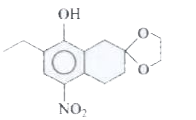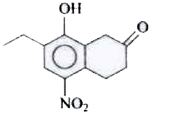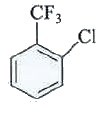In the reaction of p-chlorotoluene with KNH2 is liquid NH3 the major product is .
o-toluidine
m-toluidine
m-chloroaniline
p-chloroaniline
The correct Answer is:D
To determine the major product formed when p-chlorotoluene reacts with KNH2 in liquid ammonia, we can follow these steps:
Step 1: Identify the Reactants
The reactants in this reaction are p-chlorotoluene (C6H4ClCH3) and KNH2 (potassium amide) in a liquid ammonia medium.
Step 2: Understand the Mechanism
The reaction proceeds through the formation of a benzyne intermediate. The chlorine atom in p-chlorotoluene is a good leaving group and will be displaced by the amide ion (NH2-), leading to the generation of a benzyne structure.
Step 3: Formation of Benzyne Intermediate
When p-chlorotoluene reacts with KNH2, the chlorine atom leaves, resulting in the formation of a benzyne intermediate. The structure of the benzyne will have a triple bond between two carbon atoms in the benzene ring.
Step 4: Attack of NH2-
The NH2- ion can attack the benzyne intermediate at either the ortho, meta, or para positions. However, due to steric and electronic factors, the position of attack will influence the stability of the resulting product.
Step 5: Analyze the Possible Products
1. Ortho Attack: If NH2- attacks at the ortho position, the resulting product is ortho-toluidine. However, this position is sterically hindered due to the presence of the methyl group (CH3).
2. Meta Attack: If NH2- attacks at the meta position, the resulting product is meta-toluidine. This position is less sterically hindered and more stable.
3. Para Attack: If NH2- attacks at the para position, the resulting product is para-toluidine. This position is also stable but less favorable compared to the meta position due to the proximity of the methyl group.
Step 6: Determine the Major Product
Considering the stability of the products formed:
- The meta product is favored because the negative charge from the NH2- is further away from the electron-donating methyl group, making it more stable.
- The ortho product is less favorable due to steric hindrance.
- The para product is also less favorable compared to the meta product due to the destabilizing effect of the methyl group.
Conclusion
The major product formed when p-chlorotoluene reacts with KNH2 in liquid ammonia is meta-toluidine.
---
The reactants in this reaction are p-chlorotoluene (C6H4ClCH3) and KNH2 (potassium amide) in a liquid ammonia medium.
The reaction proceeds through the formation of a benzyne intermediate. The chlorine atom in p-chlorotoluene is a good leaving group and will be displaced by the amide ion (NH2-), leading to the generation of a benzyne structure.
When p-chlorotoluene reacts with KNH2, the chlorine atom leaves, resulting in the formation of a benzyne intermediate. The structure of the benzyne will have a triple bond between two carbon atoms in the benzene ring.
The NH2- ion can attack the benzyne intermediate at either the ortho, meta, or para positions. However, due to steric and electronic factors, the position of attack will influence the stability of the resulting product.
1. Ortho Attack: If NH2- attacks at the ortho position, the resulting product is ortho-toluidine. However, this position is sterically hindered due to the presence of the methyl group (CH3).
2. Meta Attack: If NH2- attacks at the meta position, the resulting product is meta-toluidine. This position is less sterically hindered and more stable.
3. Para Attack: If NH2- attacks at the para position, the resulting product is para-toluidine. This position is also stable but less favorable compared to the meta position due to the proximity of the methyl group.
Considering the stability of the products formed:
- The meta product is favored because the negative charge from the NH2- is further away from the electron-donating methyl group, making it more stable.
- The ortho product is less favorable due to steric hindrance.
- The para product is also less favorable compared to the meta product due to the destabilizing effect of the methyl group.
The major product formed when p-chlorotoluene reacts with KNH2 in liquid ammonia is meta-toluidine.
Topper's Solved these Questions
Similar Questions
Knowledge Check
Predict the major product of reaction:
 A
A B
B C
C D
D
Which of the compounds give cine substitution products on reaction with NaNH2 an liquid NH3 ?
A B
B C
C D
D
When 2 butyne is treated with H2 Lindlar's catalyst compund X is produced as the major product and when treated with Na.liq NH3 it product y as the major product which of the following statements is correct ?
View SolutionIn the following reaction, the major product is :

View SolutionIn the following reaction
The major product is

View SolutionThe major product in the reaction is :

View SolutionWrite the reaction of EtOH with (i) KNH2 (ii) aq. KOH (iii) Potassium ethynide.
View SolutionIn the reaction :CH3MgCl+NH3→? The product is :
View Solution

 P ( major product ), P is
P ( major product ), P is